
A. Wooden Frame
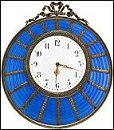
B. Blue Wedding Clock

C. Pink Triangular Clock
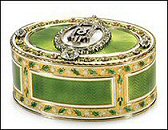
D. Bourgeois Presentation Box

E. Louis XVI Fire-Screen Frame
An object in the main exhibition room caught my fancy – a wooden frame (A.) with an autographed photograph of Tsar Nicholas II and his consort Alexandra Feodorovna. The signed photograph dated ‘1897’ has a dedication in Russian. Is it perhaps a clue to an event in the lives of the Imperial pair? A little further detective work in my library revealed the photographer to be A. Pasetti. There are doubts in my mind that this photograph was actually taken in 1897, since it is the year the couple’s second daughter Tatiana was born on May 29 (Old Style)/June 10 (New Style), and the Tsarina does not look much older than her 1894 engagement pictures.
In Houston, six spectacular pieces out of more than 100 in the McFerrin Collection are displayed in an adjoining darkened room with walk-around cases. In this review, they are presented under the artists responsible for their creation.
Mikhail Perkhin (1860-1903), a senior Fabergé workmaster, is represented in the McFerrin Collection with a blue wedding clock (B.) purchased by Tsar Nicholas II and his wife Alexander Feodorovna for 275 rubles in 1895. They had married in November 1894.
On December 4, 1901, the Imperial couple added a pink triangular clock (C.), also by Perkhin, for 215 rubles. A historical photo from the 1902 Exhibition of Objets d’Art and Miniatures held in the von Dervis Mansion in St. Petersburg, Russia, further authenticates this charming piece. The von Dervis exhibition included some twenty eggs, 16 of them made by this workshop. The accompanying Houston Museum text panel features an archival photograph of the five Imperial children next to a table with the clock on it.
The Bourgeois Presentation Box (D.) with a Perkhin mark was presented in 1902 by Tsar Nicholas II to the French politician and statesman Léon Bourgeois (1851-1925), who served as President of the Chamber of Deputies in the administration of French president Émile Loubet. Bourgeois was one of 90 foreigners to receive a snuffbox with the Emperor’s cipher, usually reserved for Russian senior politicians. This particular Fabergé presentation box was ‘transformed and embellished’ with more and larger jewels by the Russian jeweler Hahn to become a more fitting presentation piece. Interestingly enough, it was common practice for recipients, or heirs of the recipients, to return these gifts to the Imperial cabinet for a cash equivalent. Dr. Ulla Tillander-Godenhielm in The Russian Imperial Reward System, 1894-1917 (2005) states it was not ungracious to return the gift, since the gift itself was considered a subtle form of financial reward for worthy service. Obviously, the Bourgeois Presentation Box was not returned, like most gifts presented to foreigners, and therefore can be admired in Houston, Texas.
Henrik Wigström (1862-1923) inherited the Perkhin workshop after the death of his friend, and became the third and last senior workmaster responsible for most of the Tsar Imperial Easter eggs for the years 1904-1917. In the McFerrin Collection the Wigström workshop is represented by a two-sided Louis XVI Fire-Screen Frame (E.) with photographs of Tsar Nicholas and the Tsarina Alexandra Feodorovna of a later vintage. Different colored golds depict the floral motives. The various colors are made through the addition of copper, silver, zinc, iron, etc., to form an alloy, for example, green gold is 75 parts of pure gold to 25 parts of silver. Further details on the alloys used by Fabergé can be gleaned from Lowes & McCanless, Fabergé Eggs: A Retrospective Encyclopedia (2001), 275.
August Holmström (1829-1903) and his workshop created the Fabergé copies of the Imperial regalia in a one- to ten-scale miniatures. The history of the tiara in the McFerrin Collection has an interesting historical connection dating back to ca. 1810 and involves the Holmström workshop ca. 1890. Offered at auction in 2007 by Princess Marie Gabriella of Savoy, 67, the daughter of King Umberto II, the last king of Italy, and Marie-José, who is known as The May Queen since her husband the King only reigned for 27 days. Two more tiaras with a flower theme from this same workshop, after 1903 owned by August’s son Albert, are illustrated below.
Provenance: Queen Marie-José (a Belgian princess who married Umberto, the crown prince of Italy) inherited the tiara from her brother Prince Charles Theodore (1903 -1983). In his will, this exceptional jewel is referred to as ‘The Empress Josephine Tiara’ because the briolette-cut diamonds in the tiara were a gift from Tsar Alexander I of Russia (1777-1825) to Empress Josephine (1763-1814). The Tsar used to bring presents for Josephine when he visited her at La Malmaison following her divorce from Napoleon in 1809.
The tiara was purchased after World War I in Switzerland by the King of Belgium from the collection of the Dukes of Leuchtenberg, a title first granted to Eugène de Beauharnais, son of the Empress Josephine, and adopted son of Napoleon, on the occasion of his marriage to Princess Augusta Amalia, daughter of King Maximilian of Bavaria. Their youngest child, Prince Maximilian Joseph married in 1839 Grand Duchess Maria Nikolaevna of Russia, eldest daughter of Tsar Nicholas I. (Christie’s London, June 13, 2007, Important Jewellery, Lot 41)
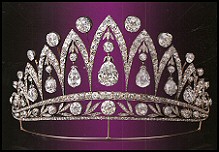
Empress Josephine Tiara
(Courtesy Christie’s)
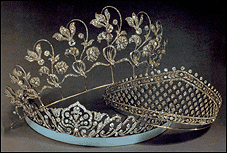
Cyclamen and Forget-me-not Flower Tiaras
(Courtesy Wartski)
In Houston the tiara is displayed so visitors bending their knees a bit can admire the tiara optically placed on their own heads. A video about the tiara narrated by Joel Bartsch is on the Houston web page.
Albert Holmström (1876-1925) inherited his late father’s workshop in 1903, and thereafter maintained the same high standards in workmanship. The 1913 Imperial Winter Egg (private collection) and the 1914 Mosaic Egg (Collection of H.M. Queen Elizabeth II of England) were designed by Alma Pihl. The Nobel Ice Egg in the McFerrin Collection was designed by Alma Pihl and features the snowflake theme developed for one of Fabergé’s most prolific clients. Dr. Emanuel Nobel (1859-1932), nephew of the dynamite inventor Alfred Nobel, operated the Nobel Brothers Petroleum Production Company in Baku (now Azerbaijan), Russia, and by April 1917 employed 50,000 workers, producing one-third of Russia’s crude oil, 40% of all refined oil, and supplying two-thirds of all the total domestic consumption.
Alma Pihl (1888-1976) began her career with Fabergé sketching drawings in design stock books for her uncle, Albert Holmström. Her design talent found its full expression in the snowflake theme epitomized in the Winter Egg, and therefore, scholars suggest the Nobel Ice Egg was made in the Holmström workshop between 1910 and 1914. (Lowes and McCanless, Fabergé Eggs: A Retrospective Encyclopedia [2001], 170-1, 279.) The McFerrin Collection contains several additional snowflake objects possibly given as gifts by Dr. Nobel.
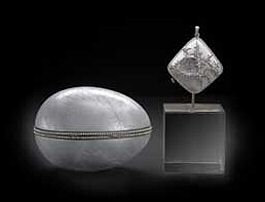
Nobel Ice Egg
(Courtesy McFerrin Collection)
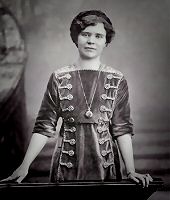
Alma Pihl
(Courtesy Ulla Tillander-Godenhielm)
An eyewitness attending the auction writes – ‘it was the most exciting auction I ever attended, 35 telephone lines were open for bidders, the sale room was overflowing with a crowd of people consisting of curious onlookers and eager bidders, and even some descendants of the Grand Duchess – there was electricity in the air.’ This auction was the highlight of the Russian week sales in London for November – December 2009. Prices realized were spectacular for objects with a fascinating provenance. Anna Brady in the Antiques Trade Gazette (December 12, 2009, 3) describes the sale by saying it had ‘BLING, provenance and a hefty dollop of romance.’
Provenance: Grand Duchess Maria Pavlovna (1854-1920), wife of Grand Duke Vladimir, brother of Tsar Alexander III, and the ‘Queen of St. Petersburg’ Society in pre-revolutionary Imperial Russia, fled to France in 1920, where she died a short while later. In 1918, Professor Richard Bergholz delivered two pillowcases stuffed with cufflinks, cigarette and cigar cases belonging to the Grand Duchess to the Swedish Legation in Petrograd. In January of 2009, they were discovered in a vault in the Swedish Foreign Office in Stockholm and the descendants put them on the auction block on November 30, 2009, Sotheby’s London. All 110 lots were sold for a total of $11.7 million (with buyer’s premiums), seven times higher than expectations.
A share of the proceeds were set aside by the family for three causes in the spirit of the Grand Duchess – completion of the restoration of the Schlosskirche on the grounds of her childhood home in Schwerin, the publication of the first official biography of the Grand Duchess by the Friends of the Schwerin Castle, and in support of the upkeep of the Russian Orthodox Chapel in Contrexéville, France. It was built by the Grand Duchess to commemorate her late husband Grand Duke Vladimir (1847-1909), and it is here the Duchess and her son Boris are buried.
The top lots (shown below) sold without buyer’s premiums for more than $800,000 each, or between 5 to 14 times the high estimates. Readers who missed the auction may enjoy the auction preview of selected lots in a video.
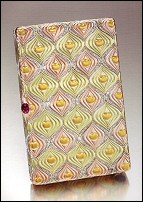

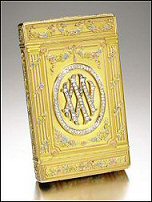
Cigarette Cases (Courtesy Sotheby’s London)
Uppsala Auktionskammare, Sweden (December 1, 2009), included a silver-mounted crystal vase marked Fabergé. Provenance: Knut Henrik Littorin employed by the Nobel family’s Branobel oil business, the largest oil company in Europe based in Baku (now Azerbaijan), Russia. Littorin advanced to become a member of the board of directors. A Fabergé brooch depicting the company’s most successful logistic inventions, a railway oil carriage (left) and the oil tanker Zoroaster (right) was also sold. In the middle of the brooch is a golden oil-drilling rig, topped by an oil cistern decorated with the Russian double-headed eagle, and on the reverse, a miniature portrait of Ludvig Nobel (1831-1888), who is credited with creating the Russian oil industry of the time. (Courtesy of Lars Ohlander)
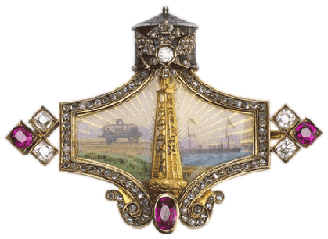
Fabergé Nobel Brooch
(Courtesy Uppsala Auktionskammare)
Russian Works of Art, Fabergé and Icons
(Updates are posted in Exhibitions on the Fabergé Research Site)
The Artie and Dorothy McFerrin Collection of more than 100 objects is on view.
December 8, 2009 – April 18, 2010 (extended) Pickett Hall in the Winter Palace, State Hermitage Museum, St. Petersburg, Russia Enamels of the World 1700-2000 from the Khalili Collections
Twenty-six works by Fabergé are included in a selection from the Khalili Collections, whose major collecting emphasis is in Islamic and Japanese art. Highlights of the exhibition curated by Dr. Marina Lopato include a combined timepiece and photograph frame, a fan, several clocks, and cigarette cases. The work of Feodor Rückert, an independent workmaster who regularly supplied Fabergé, is seen in three items. Particularly noteworthy of these is the large Olsen kovsh given to Hans ‘I.O.’ Olsen, head of domestic and foreign trade of the Nobel ‘Nafta Company’ (oil company) from 1894-1908, by the firm of Nobel Brothers in 1908. Hans Olsen returned to Norway with his family in 1908 and then lived in Sweden. He was married to Ludvig Nobel’s daughter Mina (1873-1929). (Biographical details courtesy of Dr. Ulla Tillander-Godenhielm)
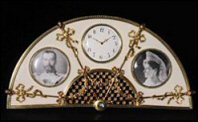
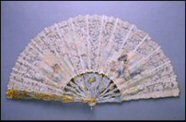
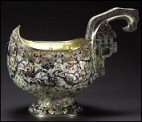
Timepiece/Photograph Frame – Fan – Olsen Kovsh
(Courtesy Khalili Family Trust)
November 23 – December 3, 2010 Wartski, London The Last Flowering of Court Art A Russian Private Collection of Fabergé
Gathered over a period of 20 years the collection includes some of the firm’s most poetic works – a flower, a hardstone figure, an Imperial Presentation Box, and a group of animal studies, the latter favorites of this anonymous private collector.
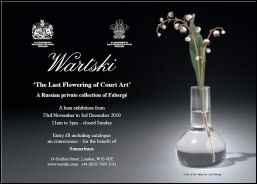
Lecture in New York City by Peter Schaffer of A La Vieille Russie, “Will the Real Fabergé Please Stand Up“, April 14, 2010
Fabergé Eggs – The Extraordinary Story of the Masterpieces that Outlived an Empire by Toby Faber published in 2008 is now available as an audio book, and is being reprinted in the hard cover edition.
After nearly 60 years, the Ministry of Defense has vacated the Alexander Palace at Tsarskoe Selo near St. Petersburg, Russia. Plans are already underway to restore the former palace staterooms (to be ready by June 2010), and to open a Romanov museum and cultural center. The video showing the first images of the Alexander Palace staterooms is courtesy of Royal Russia News, November 2009.
Paul Gilbert has announced the cessation of Gilbert’s Royal Digest to be replaced by a new magazine entitled Royal Russian Annuals. The inaugural issue, to be published in the Spring of 2010, will feature stories about the life and times of Grand Duke Vladimir Alexandrovich and his wife Maria Pavlovna. Royal Russia is pleased to announce plans for its next tour to Russia. Imperial Palaces & Country Estates Tour is scheduled for the summer 2011.
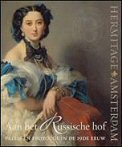
At the Russian Court
Hermitage Amsterdam

Persimmon Hodges Family Collection
(Courtesy NOMA)
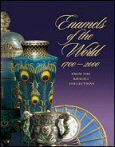
Enamels of the World
from the Khalili Collection
The exhibition At the Russian Court in the recently opened Hermitage Amsterdam drew more than 700,000 visitors in the first six months, doubling the number predicted. More than 10,000 copies of the catalogue were sold.
Baden-Baden, Germany
A judge in Frankfurt, Germany, has ruled the Fabergé Museum opened in May 2009 by Alexander N. Ivanov, owner of the Rothschild Fabergé Egg Clock, may once again use its original name. According to the press report in the Badisches Tagblatt (January 15, 2010), the legal challenge was brought before the German courts on behalf of Fabergé Services Ltd., incorporated in the Cayman Islands. The online report continues, the Fonds Pallinghurst Resources (London) operates as part of Fabergé Services and intends to establish the name ‘Fabergé’ as an exclusive luxury product.
Baltimore, Maryland
The Walters Art Museum recently featured new high resolution images of its two original Imperial Fabergé eggs – Gatchina Palace and Rose Trellis Eggs – in an Art Object of the Week column by the museum’s director, Gary Vikan.
New Orleans, Louisiana
John W. Keefe in an article in the Arts Quarterly (January/February/March 2010, 15) of the New Orleans Museum of Art discusses the addition of a bronze figure of a horse by Fabergé to the Hodges Family Collection. Persimmon was King Edward VII’s favorite and most successful racehorse, and this only extant statue of Persimmon is one of six commissioned by the King from Fabergé in 1908.
Richmond, Virginia
May 1, 2010, is the grand opening date for the $150 million building expansion of the Virginia Museum of Fine Arts. The Pratt Collection of Fabergé will re-open in the space it has occupied in recent years. Treasures to see include five Imperial Easter Eggs.
St. Petersburg, Russia
– State Hermitage Museum December 8, 2009 – April 18, 2010 (extended), Enamels of the World venue is discussed under EXHIBITION NEWS.
– Nathalie Cooper, reporting two years ago in the Moscow Times (December 7, 2007, 6), stated the Link of Times Foundation intends to open a St. Petersburg Museum in the renovated Shuvalovsky Palace. In an earlier report, renovation of the crumbling and depressing building with a $10 million infusion from the Link of Times Foundation was to be completed sometime in 2009. The project includes a 49-year lease, the longest allowed for a historical building in Russia. The intent of the Foundation is ”to find and repatriate cultural and historical artworks of significance”, with one of the landmarks being the works of Carl Fabergé (1842-1920). Russian businessman Viktor Vekselberg bought the Forbes Magazine Collection of Fabergé in 2004. At newsletter press time no further information is available on the progress of this project.
Washington, DC
In December 2009, the Fabergé Arts Foundation (FAF) changed its name to the St. Petersburg Conservancy (SPC). Its latest newsletter states, “FAF originally acquired the rights to its name in 1991. Through the recent transfer of trademark ownership, rights to the name now belong to Fabergé Ltd., in England, a brand of Pallinghurst Resources”.
The Conservancy began as a project of the FAF in 2001, and has built on the larger theme of conserving the heritage of St. Petersburg. The non-profit organization under the long time leadership of Joyce Lasky Reed, an international Board of Directors, and Executive Director Lyudmila Bakayutova in St. Petersburg, is proud to share this news:
Guilloché, French for ‘engine-turning’ is the mechanical cutting of lines on metal to create a design. Because the pattern is engraved, the reflection of light is enhanced through an overcoating of transparent enamel, and as the piece is moved from side to side, a moiré pattern appears. The best known, but not the first, artist using this technique was Fabergé. Some of his Imperial Easter Eggs with the technique were shown at the Paris World Exhibition in 1900. Engine turning machines were first used in the 1500-1600’s on ivory and wood. By the 1700’s, they were adopted for use with gold and silver, and the last machines were manufactured around 1948-49. Rose-engine turning machines for curved surfaces and straight-line machines for flat surfaces are used in metalworking, such as decorating fine watches, cigarette lighters and pens.
Peter Rowe, a commercial and custom jeweler, describes the process used by Fabergé. Alexander Caldwell of Vivian Alexander™ uses the process in creating modern egg purses and other gifts. He concurs with Peter Rowe that the work is slow, very tedious, the output small, and therefore, expensive.
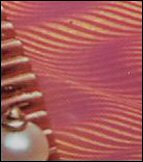
1902 Fabergé Rothschild
Egg Clock
(Courtesy Christie’s)
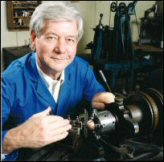
Caldwell with Rose Engine
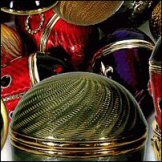
Vivian Alexander™ Guilloché
Percy Bysshe Shelley, English poet (1792-1822)

St. Petersburg, Russia – Hermitage Museum in the Snow
(Courtesy Galina Korneva)
